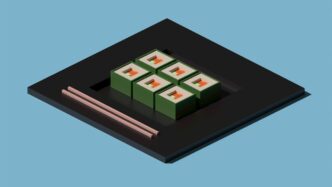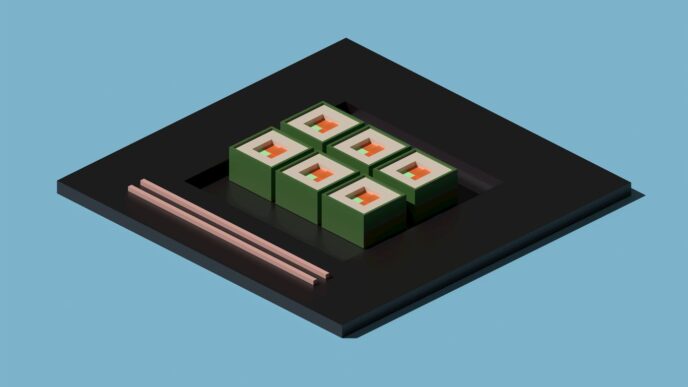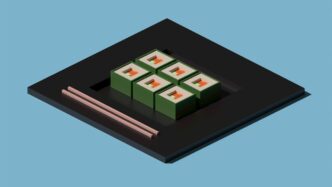D-Wave Systems is making some serious waves in the world of quantum computing. You might have heard about quantum computers and wondered what all the fuss is about. Well, D-Wave is one of the companies actually building them, and they’re focusing on a specific type called quantum annealing. This isn’t your everyday laptop; it’s a whole different ballgame designed to tackle some really tough problems that even the best supercomputers struggle with. Think of it as a specialized tool for incredibly complex tasks, and D-Wave is trying to make this powerful technology accessible.
Key Takeaways
- D-Wave Systems is a leader in quantum annealing, a specific approach to quantum computing focused on solving complex optimization problems.
- The Advantage2 system represents a significant advancement, demonstrating quantum supremacy by solving a materials simulation problem much faster than classical computers.
- Strategic partnerships with government agencies and global tech companies are expanding D-Wave’s market reach and validating its technology for real-world use.
- The quantum computing market is growing rapidly, and D-Wave is positioned in a valuable niche, though challenges like talent shortages remain.
- While D-Wave shows strong commercial progress and potential, investors should balance excitement with an understanding of the long-term risks and the evolving quantum landscape.
D-Wave Systems: Pioneering Quantum Annealing
D-Wave Systems has been in the quantum computing game for a while now, focusing specifically on a type of quantum computation called quantum annealing. It’s not quite the same as the universal quantum computers some other companies are chasing, but it’s really good at solving a specific kind of problem: optimization. Think of it like having a super-specialized tool that’s incredibly efficient for certain tasks, rather than a general-purpose hammer.
Understanding D-Wave’s Quantum Annealing Approach
So, how does quantum annealing actually work? Imagine you have a really complex problem with tons of possible solutions, and you need to find the absolute best one. Quantum annealing uses quantum mechanics to explore many of these possibilities simultaneously. Instead of trying each solution one by one like a regular computer, it can sort of ‘feel out’ the landscape of solutions, looking for the lowest point, which represents the optimal answer. This ability to explore many states at once is what gives quantum annealing its potential power for certain problems. It’s a bit like dropping a ball onto a bumpy surface and letting it settle into the lowest valley, but on a quantum level with many valleys to check out all at once.
The Evolution of D-Wave’s Quantum Processors
D-Wave hasn’t been standing still. They’ve been steadily improving their hardware. Their latest system, the Advantage2, is a big step up. It boasts over 4,400 qubits, which are the basic units of quantum information. More qubits generally mean you can tackle bigger and more complex problems. They’ve also improved how these qubits are connected and added a ‘fast anneal’ feature. This means the system can run its annealing process more quickly, getting to an answer faster. They even managed to solve a complex magnetic materials simulation problem in minutes that would take a super-powerful classical computer close to a million years. That’s a pretty wild demonstration of what this technology can do.
D-Wave’s Role in the Quantum Computing Landscape
Because D-Wave focuses on annealing, they’ve carved out a specific niche. While others are working on general-purpose quantum computers that could theoretically do anything, D-Wave is already providing practical solutions for optimization problems. This is huge for industries like finance, logistics, and drug discovery, where finding the best solution quickly can make a massive difference. They’ve partnered with all sorts of organizations, from universities to government agencies, getting their technology into the hands of people who can actually use it to solve real-world issues. This practical, problem-solving approach is what sets D-Wave apart in the fast-moving quantum world.
Advantage2: A Leap in Quantum Performance
Understanding D-Wave’s Quantum Annealing Approach
D-Wave’s whole thing has always been quantum annealing, which is a bit different from the more general quantum computing you hear about elsewhere. Think of it like this: instead of trying to solve every possible problem, D-Wave’s machines are really good at finding the best solution out of a huge number of options. They’re basically super-powered optimization machines. They use something called qubits, which are like the quantum version of computer bits, but way more flexible. These qubits can be in multiple states at once, thanks to a quantum trick called superposition. This lets the machine explore tons of possibilities simultaneously. Then there’s entanglement, where qubits get linked up, so what happens to one instantly affects the others, no matter how far apart they are. It’s pretty wild stuff, honestly.
The Evolution of D-Wave’s Quantum Processors
D-Wave has been at this for a while, and their processors have gotten seriously beefy. Their latest system, the Advantage2, is a big deal. It packs over 4,400 qubits, which is a ton, and they’ve improved how these qubits connect to each other. Plus, it has this "fast anneal" feature that speeds things up even more. This isn’t just a small upgrade; it’s a whole new level of performance for tackling those tricky optimization and AI problems. They’ve even shown it can do things classical computers just can’t keep up with. For instance, they used it to simulate magnetic materials, and it crunched through a problem in minutes that would take a regular supercomputer close to a million years. That’s what they call "quantum supremacy," and it’s a pretty big deal for showing that these machines are actually useful for real-world stuff.
D-Wave’s Role in the Quantum Computing Landscape
So, where does D-Wave fit in the bigger quantum picture? Well, they’re kind of in their own lane with quantum annealing, focusing on optimization. This is super useful for industries that deal with a lot of complex decision-making, like logistics, finance, or even drug discovery. They’ve made their systems available through their Leap cloud platform, and companies are actually using them. We’re talking about millions of problem runs happening, with usage going up pretty fast. This shows that quantum computing is moving beyond just theory and into practical applications. They’re also partnering up with government agencies and big companies, which is helping to get their technology into more hands and prove its worth. It feels like they’re building a solid foundation for quantum solutions that businesses can actually use today.
Strategic Partnerships Driving D-Wave’s Growth
It’s pretty wild how much D-Wave has been teaming up with folks lately. They’re not just building cool quantum computers in a vacuum; they’re actively working with governments and big companies all over the place. This isn’t just about getting their name out there, though. These partnerships are actually helping them put their quantum annealing tech to work on real problems.
Collaborations in National Defense and Public Sector
So, D-Wave is making a real push into government work. They’ve teamed up with a company called Carahsoft, which basically helps them sell their quantum stuff to federal, state, and local government agencies. Think about it – solving complex problems for the public sector. Plus, they’ve got a system installed at Davidson Technologies down in Alabama. This one’s specifically for national defense applications. It sounds pretty serious, and it shows that governments see quantum computing as something important for national security.
Global Alliances for Quantum Innovation
It’s not just the US, either. D-Wave is building a global presence. They’ve got a big project going on in South Korea, working with Yonsei University and the city of Incheon. The goal is to make that area a major hub for quantum tech. They’re even putting one of their new Advantage2 systems there to help with research in things like biotech and AI. Then there’s Germany, where they’ve got a system at the Jülich Supercomputing Centre. This is a pretty big deal because that center has one of Europe’s most powerful supercomputers, and D-Wave’s tech is being integrated with it. And in Japan, NTT DOCOMO, a huge telecom company, is moving beyond just testing D-Wave’s systems and is actually using them for their work, which is a big step for quantum adoption in that industry.
Integrating Quantum Solutions with Existing Infrastructure
What’s really interesting is how D-Wave is making sure their quantum computers can play nice with the systems we already have. It’s not like you can just unplug your old computers and plug in a quantum one. For example, the partnership with the Jülich Supercomputing Centre in Germany shows how they’re linking their quantum systems with existing high-performance computing (HPC) infrastructure. This hybrid approach is key. It means companies and researchers don’t have to start from scratch. They can use D-Wave’s quantum capabilities to tackle specific, hard problems while still relying on classical computers for everything else. This makes quantum computing more accessible and practical right now.
The Quantum Computing Market and D-Wave’s Position
The whole quantum computing scene is really starting to heat up. We’re talking about a market that’s expected to jump from around $1.2 billion in 2025 to a whopping $10 billion by 2045. That’s some serious growth, with estimates pointing to a 30% annual increase. Governments and big companies are pouring money into this stuff, especially in places like the U.S., China, and Europe. It’s seen as pretty critical for national economic security, which is why you’re hearing about potential government investments in companies like D-Wave.
Projected Market Growth and Investment Trends
So, the numbers look good, right? A projected 30% compound annual growth rate is nothing to sneeze at. This isn’t just hype; there’s real money flowing in. The U.S. government, for instance, is reportedly considering taking equity stakes in quantum computing companies, which would be a huge signal to the market. This kind of backing, especially for companies seen as vital to national economic security, could really spur more investment across the board. It’s a bit of a snowball effect, where early government interest encourages private sector funding.
D-Wave’s Niche in Optimization Problems
Now, where does D-Wave fit into all this? They’ve really carved out a niche for themselves with quantum annealing. While other companies are chasing universal quantum computers, D-Wave is focusing on solving specific types of problems, particularly optimization challenges. Think about complex logistics, financial modeling, or drug discovery – these are areas where finding the best possible solution out of countless options is key. D-Wave’s approach is well-suited for these kinds of tasks, and it’s allowed them to bring commercial solutions to market faster than some of their competitors. Their Advantage2 system, with over 4,400 qubits and advanced features, is a prime example of their progress in this area.
Navigating Challenges in the Quantum Industry
It’s not all smooth sailing, though. The quantum industry is still facing some significant hurdles. Things like talent shortages, the sheer amount of energy these machines can consume, and the ongoing need for better error correction are all real issues. Plus, there’s the competition. D-Wave’s focus on annealing is smart, but they still need to keep innovating and proving their technology’s worth against other approaches. The long-term potential is massive, but getting there involves overcoming these technical and practical challenges. It’s a marathon, not a sprint, and D-Wave’s ability to keep pushing the boundaries in annealing and hybrid quantum-classical computing will be key to their continued success.
Investment Thesis: Balancing Hype with Fundamentals
Okay, so let’s talk about D-Wave and whether it’s actually worth putting your money into. It’s easy to get caught up in all the quantum computing buzz, right? Everyone’s talking about how it’s going to change everything. D-Wave has definitely seen some big stock price jumps, and that’s partly because people are excited about the future, but also because they’re actually doing things.
D-Wave’s Valuation and Investor Confidence
Right now, D-Wave’s stock price is pretty high. Some of that is definitely hype – the idea of quantum computing is just really cool. But there’s more to it. The company has been landing some significant partnerships, like with the Jülich Supercomputing Centre in Germany, which is a pretty big deal. They’re also getting attention from governments, with reports suggesting the U.S. government might even take an equity stake. That kind of backing makes investors feel a bit more secure, like the government sees this as important for the country’s future. Plus, they’ve got a decent amount of cash in the bank, which helps them keep things running and maybe even buy other companies.
Commercial Deployments and Customer Success
What sets D-Wave apart is that they’re not just talking about what quantum could do; they’re showing what it is doing. They focus on quantum annealing, which is really good for solving specific types of problems, like optimization. Think about logistics, financial modeling, or drug discovery – these are areas where finding the best solution can save a lot of time and money. Companies are actually using D-Wave’s systems for these kinds of tasks. For example, NTT DOCOMO in Japan is using their quantum systems for telecommunications. This isn’t just theoretical; it’s about practical, real-world applications. They call it "Quantum Realized," and it’s about showing that their machines work, they’re reliable, and customers are getting results.
Long-Term Potential and Near-Term Risks
So, is it a sure thing? Probably not. The whole quantum computing field is still pretty new. There are technical hurdles to overcome, and other companies are working on different kinds of quantum computers. D-Wave needs to keep leading in quantum annealing and figure out how to combine their quantum computers with regular computers effectively. It’s a bit of a gamble, for sure. But if you’re looking for a company that’s a bit ahead of the curve in a potentially massive future market, and you’re okay with some ups and downs, D-Wave is an interesting one to watch. They’ve got a head start, and they’re focused on making quantum computing useful now, not just someday. It’s a high-reward, but definitely high-risk, kind of investment, and you should probably keep your positions small if you decide to jump in. Remember, D-Wave Quantum Inc. is trying to build something entirely new.
The Convergence of Quantum Computing and AI
It’s pretty wild to think about, but we’re standing at the edge of something huge: the merging of quantum computing and artificial intelligence. AI has already changed how we handle information and make predictions, right? Well, quantum computing is set to take problem-solving to a whole new level, tackling calculations that are just too much for even the most powerful regular computers we have today. This isn’t just for the eggheads in labs; the effects of this combo will ripple out and touch pretty much everything, from how we handle healthcare to keeping our finances secure.
How Quantum Computing Enhances AI Capabilities
So, how does quantum actually make AI better? Think about training AI models. Right now, it can take ages to train really complex ones. Quantum algorithms, like the Quantum Approximate Optimization Algorithm (QAOA), could slash that training time. It’s like going from walking up a ladder one rung at a time to somehow being able to jump multiple rungs at once. Plus, quantum computers can sift through massive amounts of data in ways we can’t even imagine now. This means AI could find patterns and insights in things like genetic data or climate information that are currently hidden from us.
Here’s a quick look at what quantum brings to the AI table:
- Faster Training: Quantum algorithms can speed up the learning process for AI models significantly.
- Deeper Data Analysis: AI can analyze larger and more complex datasets, uncovering hidden connections.
- Solving Tougher Problems: Tackling optimization and simulation tasks that are currently out of reach.
Solving Complex Problems with Quantum-AI Integration
When you put quantum computing and AI together, you get a powerhouse for solving really tricky problems. Imagine trying to figure out the best way to manage global supply chains to cut down on waste and costs. A quantum-AI system could crunch those numbers and find an optimal solution way faster than anything we have now. Or think about discovering new materials for better batteries or more efficient solar panels. Quantum simulations can model molecules in detail, speeding up the discovery process. It’s not just about speed, though; it’s about tackling problems that were previously considered impossible. This kind of integration could lead to breakthroughs in areas like drug discovery, helping us understand diseases better and develop new treatments. We’re talking about potentially curing diseases that have long troubled humanity.
The Future Impact on Various Industries
The impact of this quantum-AI fusion is going to be widespread. In finance, it could mean more accurate risk assessments and better investment strategies by processing complex market data. For healthcare, it means faster drug development and personalized medicine. Even traffic systems in cities could become way more efficient, reducing congestion and pollution. It’s a bit like how AI became common in our daily lives, but on a much grander scale. Of course, it’s not all smooth sailing. There are big technical hurdles to overcome, like making quantum computers more reliable and less prone to errors. Plus, we need to think about the ethical side of things – how do we make sure these powerful tools are used responsibly and don’t make existing inequalities worse? It’s a lot to consider as we move forward into this new era of quantum machine learning.
But the potential benefits are enormous. We could see new industries emerge, create new kinds of jobs, and develop ways to secure our data that are virtually unbreakable. It’s a future that promises incredible advancements, but one that also requires careful thought and planning to get right.
The Road Ahead for D-Wave
So, where does this leave us with D-Wave? They’ve definitely made some big moves, launching new tech like the Advantage2 and getting it into the hands of government agencies and big companies. It’s clear they’re not just talking about the future; they’re building it, especially in the area of optimization problems. While the whole quantum computing field is still pretty new and has its share of challenges, D-Wave seems to have a solid plan. They’re focusing on what they do best, and that’s getting real-world results. For anyone watching this space, D-Wave is a company worth keeping an eye on as quantum computing continues to grow.
Frequently Asked Questions
What exactly is D-Wave’s main focus in quantum computing?
D-Wave is really good at something called quantum annealing. Think of it like a special tool designed to solve tricky problems where you need to find the best possible answer out of many options, like figuring out the most efficient delivery route or designing new materials.
What’s new and exciting about D-Wave’s Advantage2 system?
The Advantage2 is a big step up! It has way more qubits (the basic building blocks of quantum computers) and can solve problems much faster. It even showed it could solve a science problem that would take regular computers ages, proving quantum computers can do things classical ones can’t.
How is D-Wave working with others to use quantum computers?
D-Wave is teaming up with lots of different groups, like government agencies for national defense and universities for research. They’re also working with big companies to connect quantum computers with the systems we already use, making quantum technology more accessible.
Is the quantum computing market growing, and where does D-Wave fit in?
Yes, the quantum computing market is expected to get much bigger! D-Wave is focusing on problems that need the best possible solutions, which is a sweet spot for their technology. This helps them stand out as more companies and governments invest in this field.
Why are people investing in D-Wave, and what are the risks?
Investors are excited because D-Wave has real-world examples of its technology working and has made important partnerships. However, like any new technology, there are risks. D-Wave needs to keep leading in its area and keep improving its systems to stay ahead.
How can quantum computing and AI work together?
Quantum computing can give AI a super boost! It can help AI learn faster and solve much more complex problems, like discovering new medicines or understanding climate change better. This combination could lead to amazing new discoveries and solutions.














